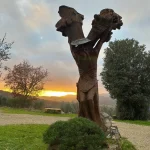Behind the placement of this wooden statue depicting Christ lies the fascinating story of two towns that, despite being far apart, share the same origin. Pergine Valdarno and Pergine Valsugana are two towns that share the same name and a history tied to the Etruscan origins of the populations that settled in these areas of Northern Italy. After the annexation of Trentino to the Kingdom of Italy following World War I, both towns, which had always been called simply “Pergine,” were necessarily distinguished as “Pergine Valsugana” in the province of Trento and “Pergine Valdarno” in the province of Arezzo.
To seal this common history, in 1989, the two towns officially became twin towns, signing an act of friendship. As a symbol of this bond, Pergine Valsugana donated a precious wooden statue carved from chestnut wood to Pergine Valdarno, depicting a crucified Christ and placed in an olive grove. Behind the statue, one can admire the Scerfio Valley, inhabited since Etruscan times and an important communication route for centuries.
The Florentine Republic, which had taken control of the area in 1337, aimed to control the military strongholds of the Ubertini family in the Valdambra to secure safe roads to the Valdichiana. Thus, at the far left end of the valley, the construction of the new city of Giglio Fiorentino was planned, also known as “the city that doesn’t exist.” This project was part of the ambitious plan of the Republic of Florence to create new settlements, such as San Giovanni Valdarno, Terranuova Bracciolini, Fiorenzuola, Castelfranco, and others. In 1350, excavation work for the new city began, but the project was interrupted due to the outbreak of the conflict between Florence and Milan in 1351.
The surrounding landscape is so distinctive that the evocative space of the Christ of the Olives is often chosen to host events and concerts.




